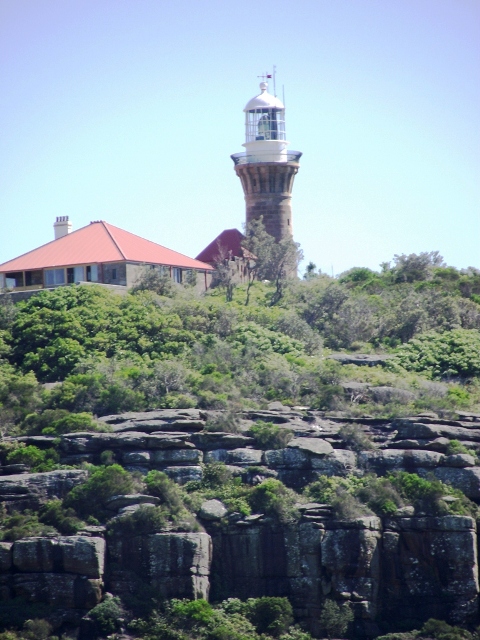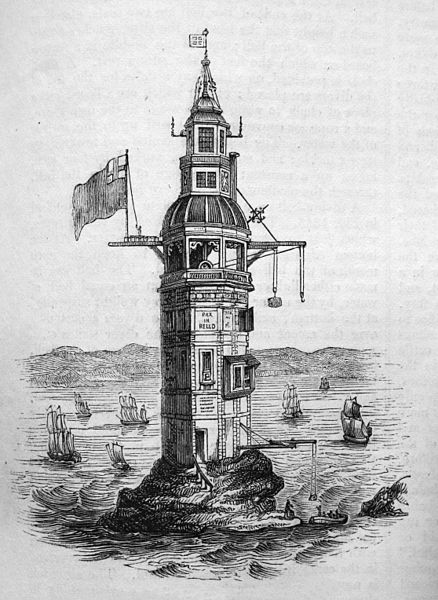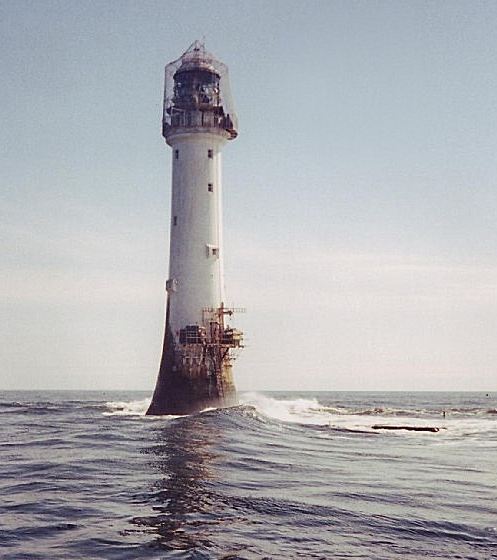August 4 - 10, 2013: Issue 122
Mr Wiseacre Discourses. ON LIGHTHOUSES.
 Mr. Wiseacre,' said Megsie, 'who first thought of making a lighthouse?'.
Mr. Wiseacre,' said Megsie, 'who first thought of making a lighthouse?'.
'Ah, pet, I see that looking at Barrenjoey has put that into your mind. The history of the lighthouse goes back a long way, though these helps to the sailors were very few. Even in the days of Columbus, to venture outside the Mediterranean was torisk1 great dangers from shoals and reefs. There were no friendly lights by which they could steer safely into a harbour.'
'Wasn't there a famous lighthouse long ago?'
'You mean, I suppose, the Pharos of Alexandria, which was built in the third century B.C. As a matter of fact, Pharos was the name of the island on which it was built, but not only was the lighthouse so called, but in several languages today the term is used for a beacon.
'Wasn't there a colossus lighthouse?'
'To be sure, there was, Joe. A gigantic figure at the entrance to the harbour of Rhodes; but it did not last long, for it was too big and elaborate to stand the force of storms. Another great lighthouse was built by the Romans on the French side of the English Channel. This was in the form of a great tower, 192 feet round, and 1200 feet high, which guided mariners for more than 14 centuries.'
'What did they use for a light in those days? Some kind of lamp, I suppose.'
'Generally, a metal basket containing fuel, which, of course, had to be kept up by men appointed for the purpose. Nowadays, the lights are generally kerosene, acetylene or electric, and are automatic, so that there is no need to have anyone attend to them. The light is turned on or off by ;a sun valve.'
'Are all lighthouses like that one over there?'
'More or less, Megsie. The cylindrical shape has been found best to withstand the weather. They are not always on a high cliff like the one you are looking at and the great light at South Head. The famous Eddystone lighthouse is built on a rock.'
'I know who built it; a chappie named; Winstanley. '
 Left: Winstanley's Lighthouse at the Eddystone - engraving, circa 1880, After Henry Roberts' 1761 engraving - Charles Knight - editor and right; The current lighthouse and the stub of Smeaton's Tower.
Left: Winstanley's Lighthouse at the Eddystone - engraving, circa 1880, After Henry Roberts' 1761 engraving - Charles Knight - editor and right; The current lighthouse and the stub of Smeaton's Tower.
'He certainly built the first one, Joe; but it was not to last very long, for he was eccentric, and designed a wooden pagoda-like structure, with a high roof, and many ornamental projections. The whole was covered with gaudy paintings and gilded inscriptions.'
'What good would they do?'
'None at all Joe. Many experienced men pointed out to Winstanley how unsuitable it was, but he always said in reply that he would like to be in his lighthouse in the worst possible storm.'
'Did he get his wish?'
'He did, Megsie. One gloomy afternoon in 1703 he set out to spend a night in his beloved lighthouse. During the night there arose one of the worst storms on record. In the morning people went to the shore to see how the lighthouse had fared.'
'I guess it was well-shaken. '
'It was gone, Joe. The rock was bare; Winstanley and his lighthouse had vanished together.'
'Isn't there one there now?'
'Indeed, there is. A second building was destroyed by fire, but the one which stands there now was built in 1882. It contains 4688 tons of stone, and has nine rooms. Its height is 133 feet.'
'Why is that such a famous lighthouse?'
'Because, Megsie, the rocks on which it is built lie in the English  'Channel, some14 miles from Plymouth, right in the track of ships.'
'Channel, some14 miles from Plymouth, right in the track of ships.'
'What are some other famous lighthouses?'
'There is the Bell Rock, off the coast of Scotland, and Minot's Ledge, 20 miles to the south-east of Boston, U.S.A.'
'Is the Bell Rock the one I learnt about in the poem?'
'Yes, Megsie. The good Abbot placed the bell there to give a warning to sailors, and the pirate sank it. Our South Headlight is also very fine, and there is a famous one at the entrance to New York harbour; Nowadays, ships can travel in safety, for nearly every part of the oceans has been charted, and lighthouses, lightships and buoys are everywhere, to give a warning. In some the light is fixed, in others it flashes at intervals. All these are recorded, and every ship has a copy of this book, so that the captain can tell where he is by observing the time of the flashes.'
 According to legend, the rock is called Bell Rock because of a 14th century attempt by the Abbot of Arbroath to install a warning bell on it. The bell lasted only one year before it was stolen by a Dutch pirate. This story is immortalised in The Inchcape Rock, a poem by 19th century poet Robert Southey. The rock was the scene of many shipwrecks as it lies just below the surface of the sea for all but a few hours at low tide. The Bell Rock Lighthouse, off the coast of Angus, Scotland, is the world's oldest surviving sea-washed lighthouse.The Scottish engineer Robert Stevenson had proposed the construction of a lighthouse on Bell Rock in 1799, but cost concerns and the relatively radical nature of his proposal caused it to be shelved. However, the loss of the warship HMS York and all on board in 1804 resulted in a furore in Parliament which eventually led to legislation being passed in 1806 enabling construction to begin. Construction was finished in 1810. Since the construction of the lighthouse no shipwrecks have been recorded on the Bell Rock except for that of HMS Argyll during wartime blackouts in 1915. Photo: Bell Rock Lighthouse courtesy Geograph. Situated 11 miles out from Arbroath the lighthouse was built by Robert Stevenson in 1811, upon the infamous Inchcape reef. At high water the reef is hidden about 12 foot below the water level, at low water it is 4 foot above the sea.
According to legend, the rock is called Bell Rock because of a 14th century attempt by the Abbot of Arbroath to install a warning bell on it. The bell lasted only one year before it was stolen by a Dutch pirate. This story is immortalised in The Inchcape Rock, a poem by 19th century poet Robert Southey. The rock was the scene of many shipwrecks as it lies just below the surface of the sea for all but a few hours at low tide. The Bell Rock Lighthouse, off the coast of Angus, Scotland, is the world's oldest surviving sea-washed lighthouse.The Scottish engineer Robert Stevenson had proposed the construction of a lighthouse on Bell Rock in 1799, but cost concerns and the relatively radical nature of his proposal caused it to be shelved. However, the loss of the warship HMS York and all on board in 1804 resulted in a furore in Parliament which eventually led to legislation being passed in 1806 enabling construction to begin. Construction was finished in 1810. Since the construction of the lighthouse no shipwrecks have been recorded on the Bell Rock except for that of HMS Argyll during wartime blackouts in 1915. Photo: Bell Rock Lighthouse courtesy Geograph. Situated 11 miles out from Arbroath the lighthouse was built by Robert Stevenson in 1811, upon the infamous Inchcape reef. At high water the reef is hidden about 12 foot below the water level, at low water it is 4 foot above the sea.
'How do they make the flashes?’
‘A revolving screen alternately covers and shows the light. Sometimes there will be a series of flashes, and then a steady light for a few seconds.'
'Clever!!’
‘It is necessary John for navigation at night is not easy, especially when the captain is not used to the various channels and shoals.'
'There are plenty of lighthouses round Australia, I suppose?'
'I think we could do with a few more, especially among the coral reefs. However, shipwrecks are not common now, for most coasts are well lighted, and then the wireless is a great help.'
'That brings help if they are sinking.'
'Yes, Joe, but it has other uses, as warnings of approaching storms can be sent out, and if there is any doubt as to a dangerous reef, advice, can be asked. Now, I think we must end our little talk, for I want to take you round by Church Point. Here is a little verse for you to learn and remember:
“There are lighthouses all along our lives,
And God knows when 'tis time to light the lamps.”
Even Joe, the irrepressible, was silent after this, though he soon moved towards the car to get his favourite tea-basket.
Mr. Wiseacre Discourses. (1934, February 22). The Catholic Press (NSW : 1895 - 1942), p. 33. Retrieved from http://nla.gov.au/nla.news-article104400990
